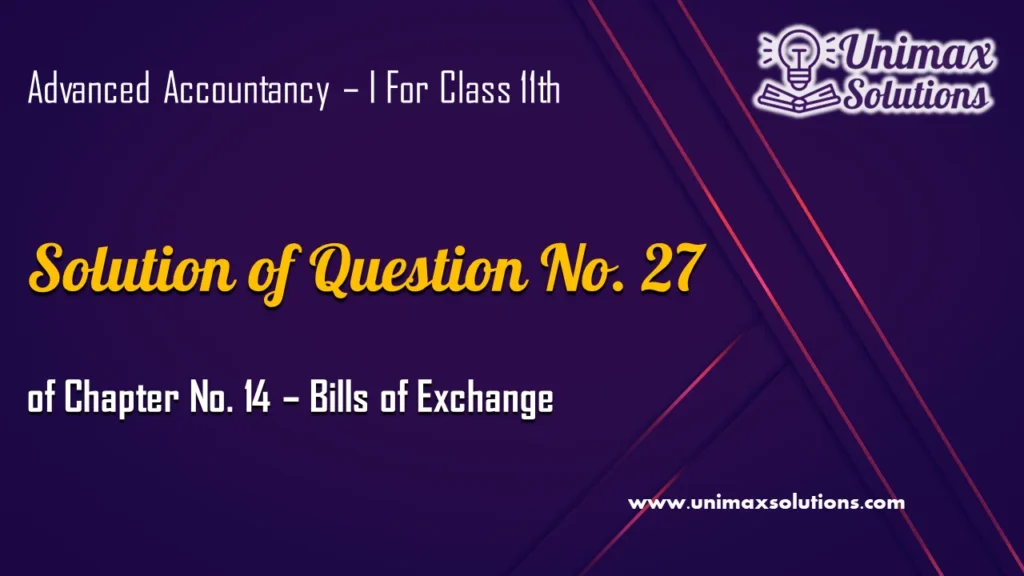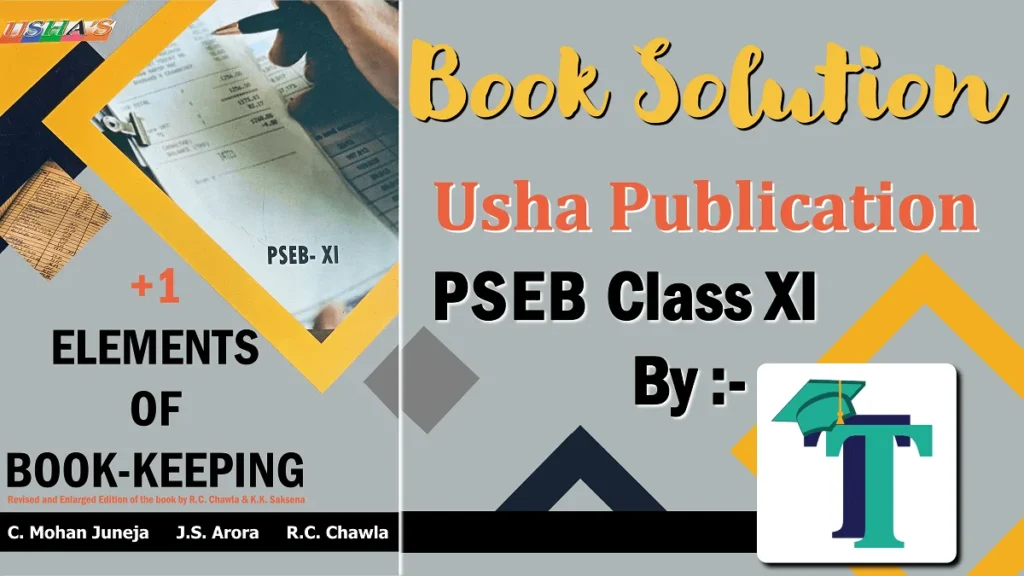
Advertisement
Question 27 Chapter 14 – Class 11 Unimax
27. Shubham draws on Rajendra a bill for ₹ 45,000 on 1st June, 2019 for 3 months. Rajendra accepts the bill and sends it to Shubham who gets it discounted for ₹ 44,100. Shubham immediately remits ₹ 14,700 to Rajendra. On the due date Shubham, being unable to remit the amount due accepts a bill for 63,000 for three months which is discounted by Rajendra for ₹ 61,650. Rajendra sends ₹ 11,100 to Shubham. On the due date Shubham become insolvent, his estate paying forty paise in the rupee. Given journal entries in the books of Shubham and Rajendra.
The solution of Question 27 Chapter 14 – Class 11 Unimax
| Journal for Mr. ‘Shubham’ (Drawer) | |||||
| Date | Particulars | L.F. | Debit | Credit | |
| 2019 | |||||
| June 1 | Bill receivable A/c | Dr. | 45,000 | ||
| To Rajendra’s A/c | 45,000 | ||||
| (Being acceptance of bill received from Rajendra for mutual accommodation) | |||||
| June 1 | Bank A/c | Dr. | 44,100 | ||
| Discount A/c | Dr. | 900 | |||
| To Bills receivable A/c | 45,000 | ||||
| (Being bill discounted with bank) | |||||
| June 1 | Rajendra’s A/c | Dr. | 15,000 | ||
| To Cash A/c | 14,700 | ||||
| To Discount A/c | 300 | ||||
| (Being a part of bill remitted to Rajendra immediately) | |||||
| Sept. 4 | Rajendra’s A/c | Dr. | 63,000 | ||
| To Bills payable A/c | 63,000 | ||||
| (Being acceptance of bill given to Rajendra) | |||||
| Sept. 4 | Cash A/c | Dr. | 11,100 | ||
| Discount A/c | Dr. | 900 | |||
| To Rajendra’s A/c | 12,000 | ||||
| (Being cash received from Rajendra and discount allowed) | |||||
| Dec. 7 | Bill payable A/c | Dr. | 63,000 | ||
| To Rajendra’s A/c | 63,000 | ||||
| (Being bill not met on due date) | |||||
| Dec. 7 | Rajendra’s A/c | Dr. | 42,000 | ||
| To cash A/c | 16,800 | ||||
| To Deficiency A/c | 25,200 | ||||
| (Being insolvent, only 40% amount paid to Rajendra) | |||||
| Journal for Mr. ‘Rajendra’ (Drawee) | |||||
| Date | Particulars | L.F. | Debit | Credit | |
| 2019 | |||||
| June 1 | Shubham A/c | Dr. | 45,000 | ||
| To Bill payable A/c | 45,000 | ||||
| (Being acceptance of bill given to Shubham for 3 months) | |||||
| Nov. 3 | Cash A/c | Dr. | 14,700 | ||
| Discount A/c | Dr. | 300 | |||
| To Shubham A/c | 15,000 | ||||
| (Being cash received from Shubham and discount allowed) | |||||
| Sept. 4 | Bills payable A/c | Dr. | 45,000 | ||
| To Cash A/c | 45,000 | ||||
| (Being payment of bill made on due date) | |||||
| Sept. 4 | Bills payable A/c | Dr. | 63,000 | ||
| To Shubham A/c | 63,000 | ||||
| (Being acceptance of bill received from Shubham) | |||||
| Sept. 4 | Bank A/c | Dr. | 61,650 | ||
| Discount A/c | Dr. | 1,350 | |||
| To Bill payable A/c | 63,000 | ||||
| (Being bill discounted with bank) | |||||
| Sept. 4 | Shubham A/c | Dr. | 12,000 | ||
| To Cash A/c | 11,100 | ||||
| To Discount A/c | 900 | ||||
| (Being cash paid to Shubham) | |||||
| Dec. 7 | Shubham A/c | Dr. | 63,000 | ||
| To Bank A/c | 63,000 | ||||
| (Being bill not met on due date) | |||||
| Dec. 7 | Cash A/c | Dr. | 16,800 | ||
| Bad debts A/c | Dr. | 25,200 | |||
| To Shubham (39,000+12,000) A/c | 42,000 | ||||
| (Being Shubham become insolvent any only 40% amount received from him) | |||||
Working Note:
(1) As soon as one party become insolvent after making dishonoured entry it should be found as to how much amount is due by Shubham to Rajendra.
(2) Discounting charges of second bill have been apportioned in the ratio in which Shubham & Rajendra shared the proceeds of second bill i.e. 2:1 shown as follows:
Total proceeds received of second bill = ₹ 61,650
Advertisement
Amount paid on behalf of partners for 1st bill
| Shubham | Rajendra | |
| 30,000 | 15,000 | |
| Balance (61,650-45,000) 16,650, distributed as | 11,100 | 5,550 |
| 41,100 | 20,550 | |
| Ratio in which proceeds of second bill shared 2:1 | ||
| Discounting charges of second bill to b shared as | 900 | 450 |
End of Solution
Check Out the Solution of all questions for this chapter:
The solutions to all questions of Chapter 14 – Bills of Exchange Unimax – Class 11 are shown as follows, click on the image of the question to get the solution.
Question 1 Chapter 14 – Class 11 Unimax
Advertisement
Question 6 Chapter 14 – Class 11 Unimax
Advertisement
1. Comprehensive Solutions for All Chapters of Advanced Accountancy I Class 11 by Unimax
UnimaxSolutions.in offers a comprehensive solution for students studying Advanced Accountancy I Part 1 in Class 11. With their meticulously curated study material, students can access comprehensive solutions to all the questions included within each chapter. By selecting the chapter name from the study material, students can easily navigate through the topics and find detailed explanations and step-by-step solutions to the problems presented in that section. Whether it’s understanding complex accounting concepts, mastering calculation techniques, or analyzing financial statements, Unimax provides a valuable resource to aid students in their learning journey. With these comprehensive solutions at their disposal, students can enhance their understanding, clarify doubts, and improve their problem-solving skills in Advanced Accountancy, ensuring they are well-prepared for their Class 11 examinations.
- Chapter No. 1 – Introduction of Accounting
- Chapter No. 2 – Theory Base of Accounting
- Chapter No. 3 – Vouchers and Transactions
- Chapter No. 4 – Journal
- Chapter No. 5 – Goods and Services Tax (GST): An Introduction
- Chapter No. 6 – Ledger
- Chapter No. 7 – Special Purpose Book – Cash Book
- Chapter No. 8 – Other Subsidiary Books
- Chapter No. 9 – Trial Balance
- Chapter No. 10 – Rectification of Errors
- Chapter No. 11 – Depreciation
- Chapter No. 12 – Provision and Reserves
- Chapter No. 13 – Bank Reconciliation Statement
- Chapter No. 14 – Bills of Exchange
- Chapter No. 15 – Financial Statements (Without Adjustments)
- Chapter No. 16 – Financial Statements (With Adjustments)
- Chapter No. 17 – Accounts from Incomplete Records – Single Entry System
2. Punjab School Education Board (PSEB) Solutions of Usha Publication.
If you’re a student enrolled in the Punjab School Education Board Class 11, it’s essential to explore a wide range of books to cover the syllabus thoroughly. While the prescribed textbooks are undoubtedly valuable, supplementing your studies with additional resources can enhance your understanding and knowledge. Consider checking out other books that align with the curriculum, offering different perspectives and insights on the subjects you’re studying. These supplementary materials can provide you with alternative explanations, practice questions, and examples that may aid in clarifying complex concepts. Moreover, exploring diverse sources can expose you to a variety of writing styles and viewpoints, fostering a broader understanding of the subjects. So, seize the opportunity to expand your learning by delving into other books that can complement your studies and contribute to your academic growth.
Advertisement

